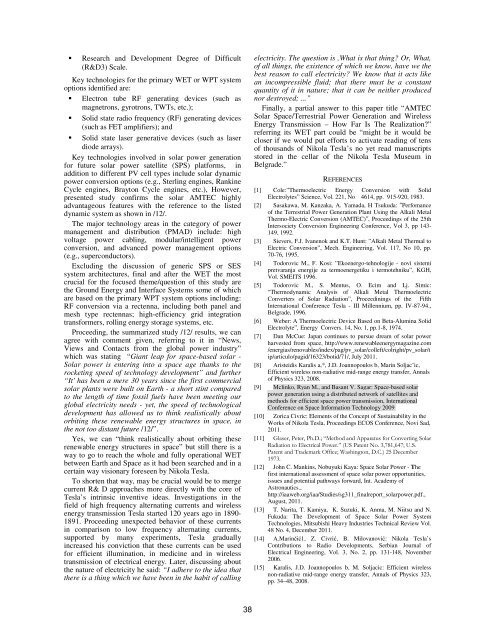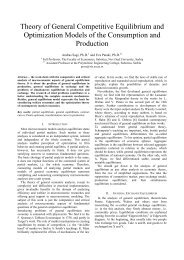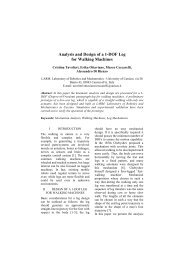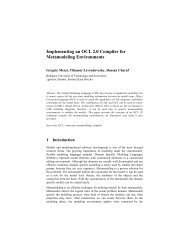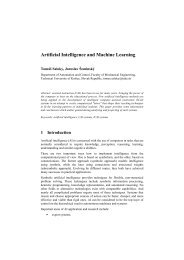Final Program EXPRES 2012 - Conferences
Final Program EXPRES 2012 - Conferences
Final Program EXPRES 2012 - Conferences
- No tags were found...
Create successful ePaper yourself
Turn your PDF publications into a flip-book with our unique Google optimized e-Paper software.
Research and Development Degree of Difficult(R&D3) Scale.Key technologies for the primary WET or WPT systemoptions identified are: Electron tube RF generating devices (such asmagnetrons, gyrotrons, TWTs, etc.); Solid state radio frequency (RF) generating devices(such as FET amplifiers); and Solid state laser generative devices (such as laserdiode arrays).Key technologies involved in solar power generationfor future solar power satellite (SPS) platforms, inaddition to different PV cell types include solar dynamicpower conversion options (e.g., Sterling engines, RankineCycle engines, Brayton Cycle engines, etc.), However,presented study confirms the solar AMTEC highlyadvantageous features with the reference to the listeddynamic system as shown in /12/.The major technology areas in the category of powermanagement and distribution (PMAD) include: highvoltage power cabling, modular/intelligent powerconversion, and advanced power management options(e.g., superconductors).Excluding the discussion of generic SPS or SESsystem architectures, final and after the WET the mostcrucial for the focused theme/question of this study arethe Ground Energy and Interface Systems some of whichare based on the primary WPT system options including:RF conversion via a rectenna, including both panel andmesh type rectennas; high-efficiency grid integrationtransformers, rolling energy storage systems, etc.Proceeding, the summarized study /12/ results, we canagree with comment given, referring to it in “News,Views and Contacts from the global power industry”which was stating “Giant leap for space-based solar -Solar power is entering into a space age thanks to therocketing speed of technology development” and further“It' has been a mere 30 years since the first commercialsolar plants were built on Earth - a short stint comparedto the length of time fossil fuels have been meeting ourglobal electricity needs - yet, the speed of technologicaldevelopment has allowed us to think realistically aboutorbiting these renewable energy structures in space, inthe not too distant future /12/”.Yes, we can “think realistically about orbiting theserenewable energy structures in space” but still there is away to go to reach the whole and fully operational WETbetween Earth and Space as it had been searched and in acertain way visionary foreseen by Nikola Tesla.To shorten that way, may be crucial would be to mergecurrent R& D approaches more directly with the core ofTesla’s intrinsic inventive ideas. Investigations in thefield of high frequency alternating currents and wirelessenergy transmission Tesla started 120 years ago in 1890-1891. Proceeding unexpected behavior of these currentsin comparison to low frequency alternating currents,supported by many experiments, Tesla graduallyincreased his conviction that these currents can be usedfor efficient illumination, in medicine and in wirelesstransmission of electrical energy. Later, discussing aboutthe nature of electricity he said: “I adhere to the idea thatthere is a thing which we have been in the habit of callingelectricity. The question is ,What is that thing? Or, What,of all things, the existence of which we know, have we thebest reason to call electricity? We know that it acts likean incompressible fluid; that there must be a constantquantity of it in nature; that it can be neither producednor destroyed; ...”<strong>Final</strong>ly, a partial answer to this paper title “AMTECSolar Space/Terrestrial Power Generation and WirelessEnergy Transmission – How Far Is The Realization?”referring its WET part could be “might be it would becloser if we would put efforts to activate reading of tensof thousands of Nikola Tesla’s no yet read manuscriptsstored in the cellar of the Nikola Tesla Museum inBelgrade.”REFERENCES[1] Cole:”Thermoelectric Energy Conversion with SolidElectrolytes” Science, Vol. 221, No 4614, pp. 915-920, 1983.[2] Sasakawa, M. Kanzaka, A. Yamada, H Tsukuda: ″Perfomanceof the Terrestrial Power Generation Plant Using the Alkali MetalThermo-Electric Conversion (AMTEC)″, Proceedings of the 25thIntersociety Conversion Engineering Conference, Vol 3, pp 143-149, 1992.[3] Sievers, F.J. Ivanenok and K.T. Hunt: ”Alkali Metal Thermal toElectric Conversion”, Mech. Engineering, Vol. 117, No 10, pp.70-76, 1995.[4] Todorovic M., F. Kosi: ”Ekoenergo-tehnologije - novi sistemipretvaranja energije za termoenergetiku i termotehniku”, KGH,Vol. SMEITS 1996.[5] Todorovic M., S. Mentus, O. Ecim and Lj. Simic:“Thermodynamic Analysis of Alkali Metal ThermoelectricConverters of Solar Radiation”, Proceedinings of the FifthInternational Conference Tesla - III Millennium, pp. IV-87-94.,Belgrade, 1996.[6] Weber: A Thermoelectric Device Based on Beta-Alumina SolidElectrolyte”, Energy Convers. 14, No. 1, pp.1-8, 1974.[7] Dan McCue: Japan continues to pursue dream of solar powerharvested from space, http://www.renewableenergymagazine.com/energias/renovables/index/pag/pv_solar/colleft/colright/pv_solar/tip/articulo/pagid/16323/botid/71/, July 2011.[8] Aristeidis Karalis a,*, J.D. Joannopoulos b, Marin Soljacˇic,Efficient wireless non-radiative mid-range energy transfer, Annalsof Physics 323, 2008.[9] Mclinko, Ryan M., and Basant V. Sagar: Space-based solarpower generation using a distributed network of satellites andmethods for efficient space power transmission, InternationalConference on Space Information Technology 2009.[10] Zorica Civric: Elements of the Concept of Sustainability in theWorks of Nikola Tesla, Proceedings ECOS Conference, Novi Sad,2011.[11] Glaser, Peter, Ph.D.; “Method and Apparatus for Converting SolarRadiation to Electrical Power.” (US Patent No. 3,781,647; U.S.Patent and Trademark Office; Washington, D.C.) 25 December1973.[12] John C. Mankins, Nobuyuki Kaya: Space Solar Power - Thefirst international assessment of space solar power opportunities,issues and potential pathways forward, Int. Academy ofAstronautics.,http://iaaweb.org/iaa/Studies/sg311_finalreport_solarpower.pdf.,August, 2011.[13] T. Narita, T. Kamiya, K. Suzuki, K. Anma, M. Niitsu and N.Fukuda: The Development of Space Solar Power SystemTechnologies, Mitsubishi Heavy Industries Technical Review Vol.48 No. 4, December 2011.[14] A.Marinčić1, Z. Civrić, B. Milovanović: Nikola Tesla’sContributions to Radio Developments, Serbian Journal ofElectrical Engineering, Vol. 3, No. 2, pp. 131-148, November2006.[15] Karalis, J.D. Joannopoulos b, M. Soljacic: Efficient wirelessnon-radiative mid-range energy transfer, Annals of Physics 323,pp. 34–48, 2008.38


